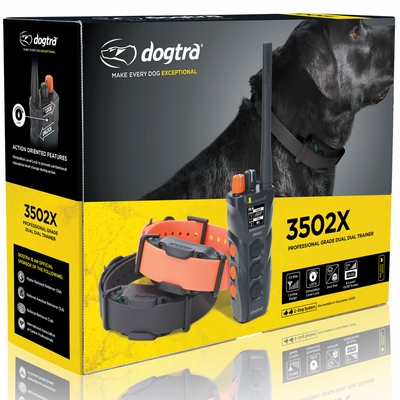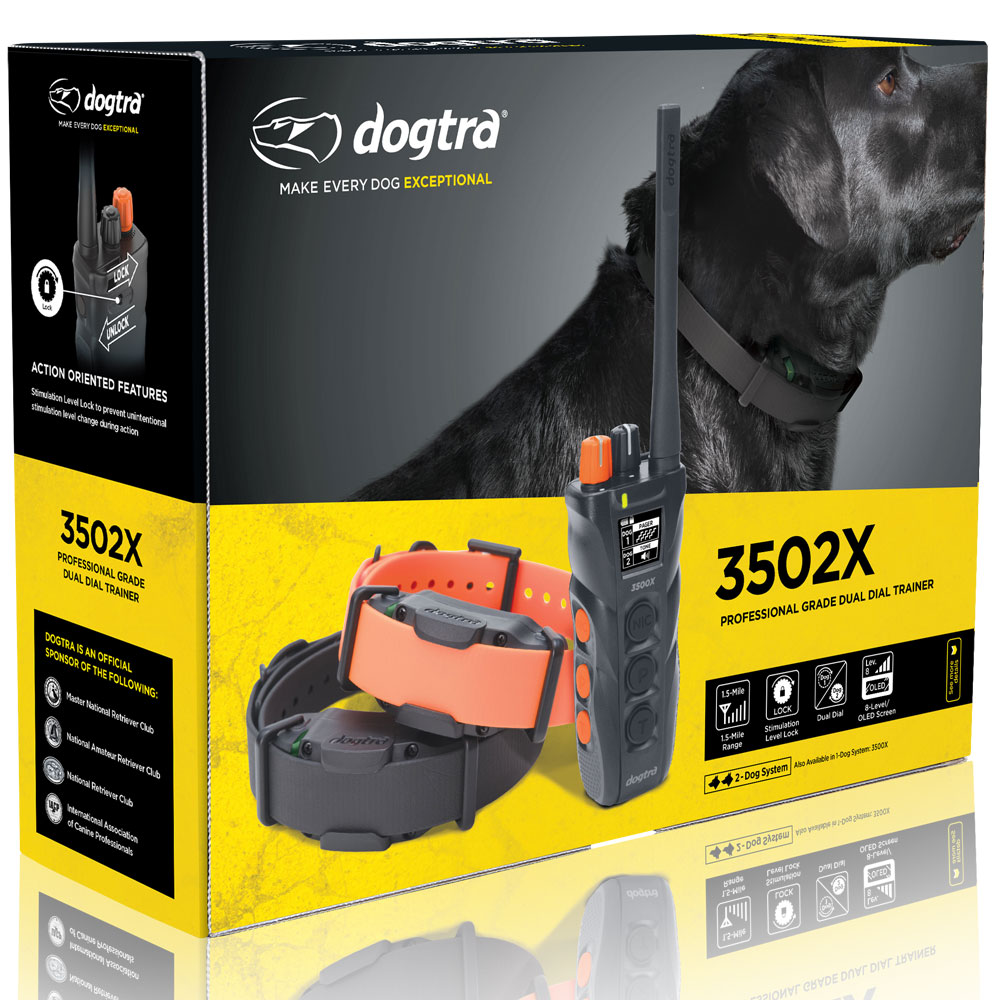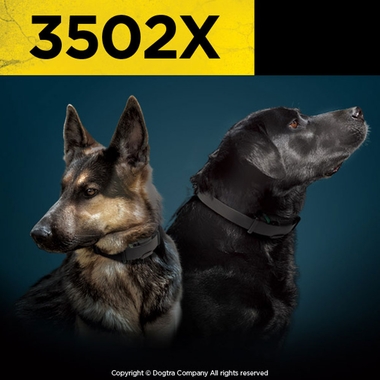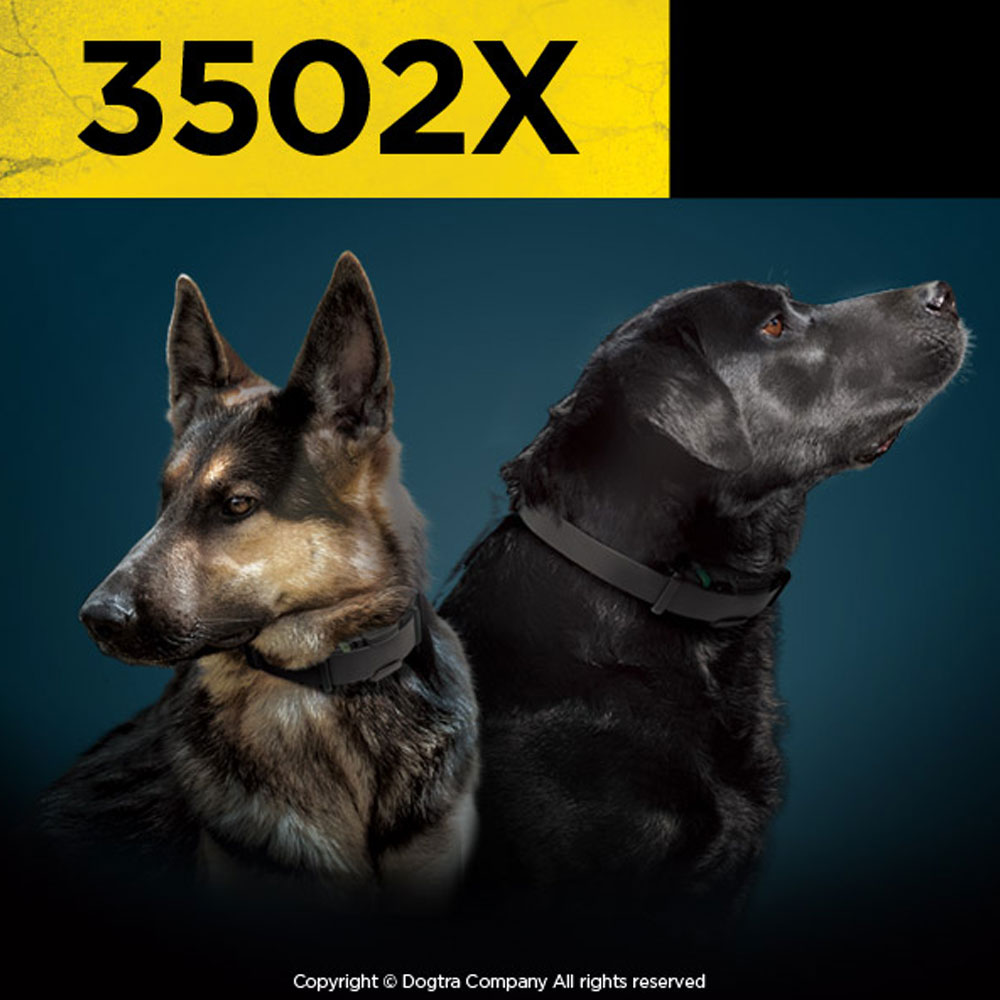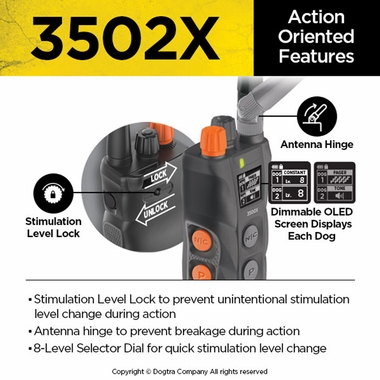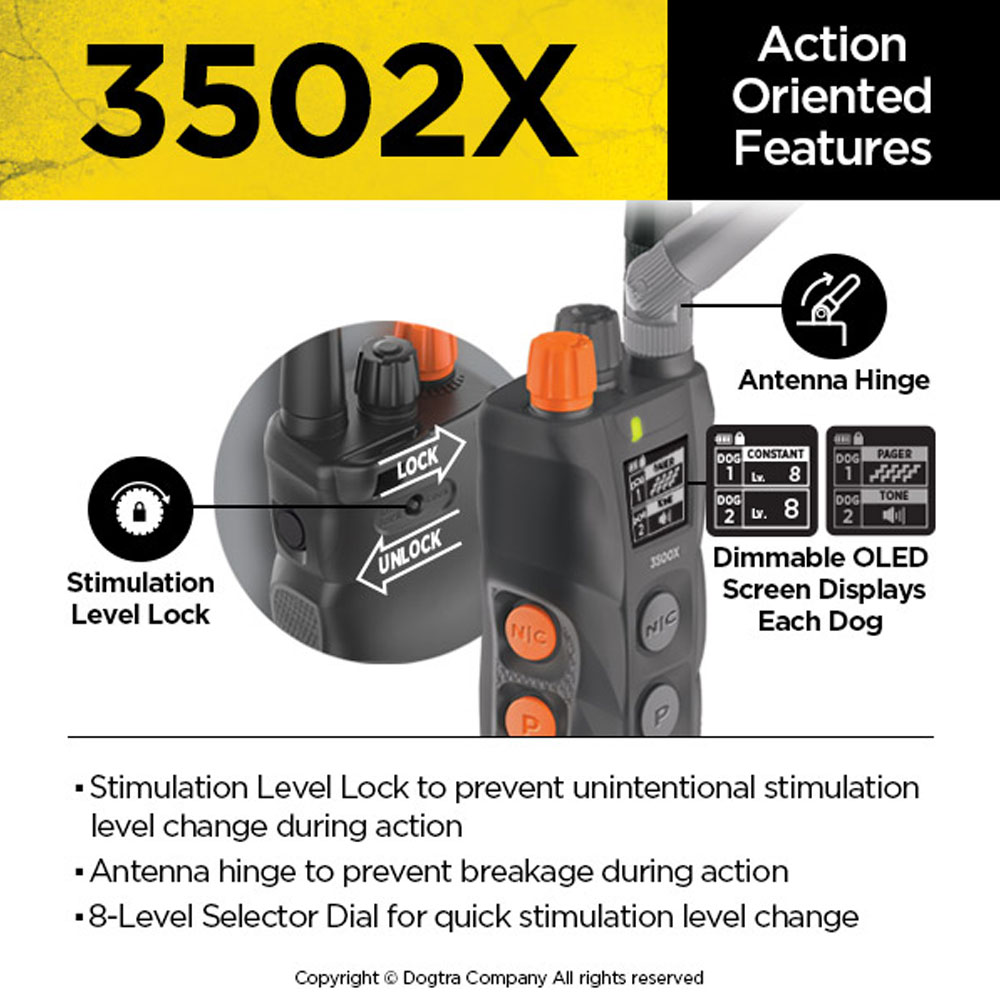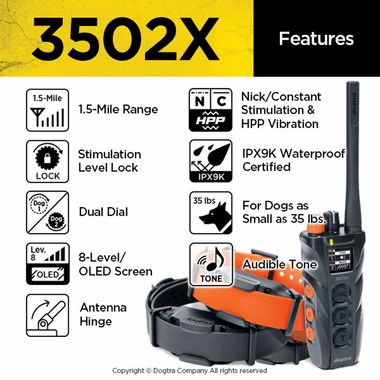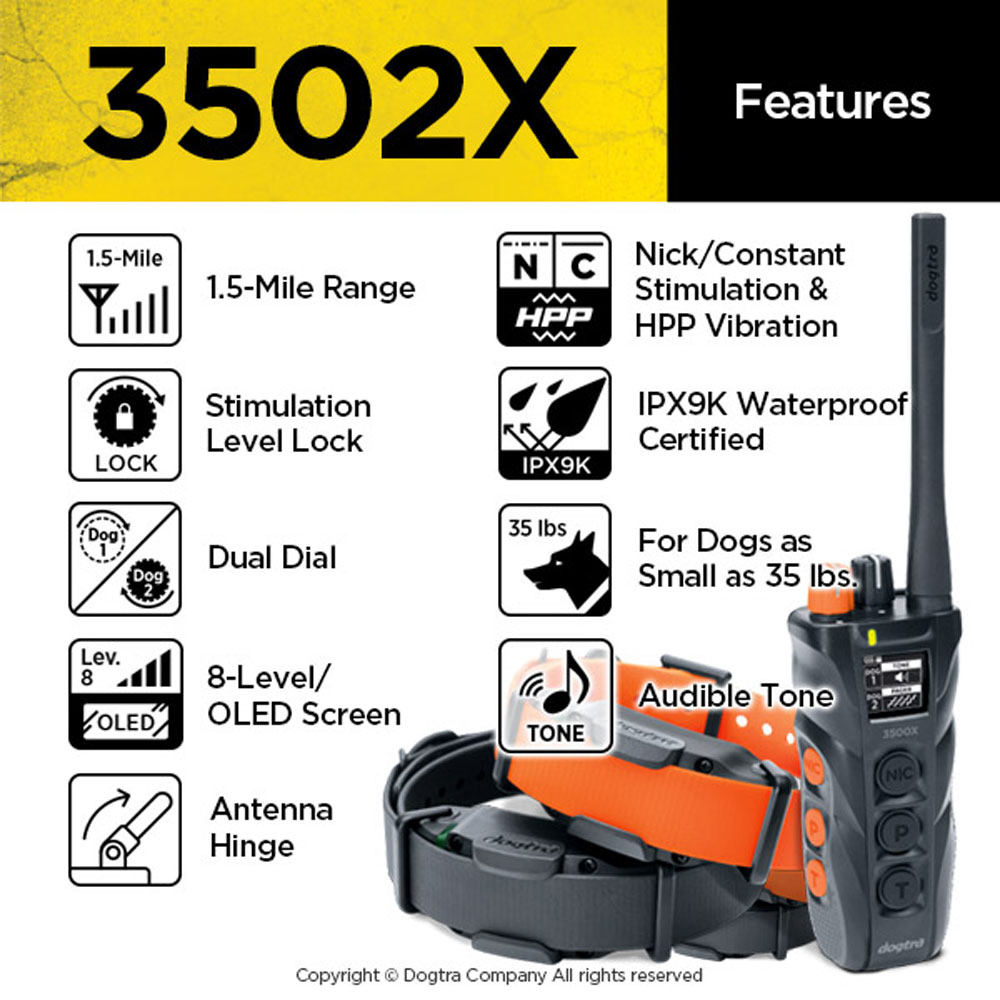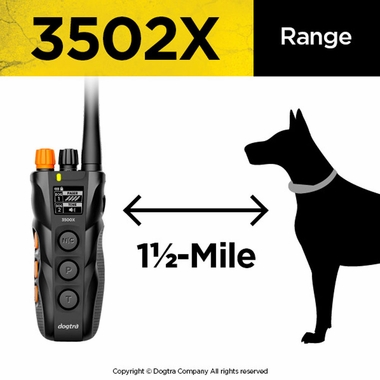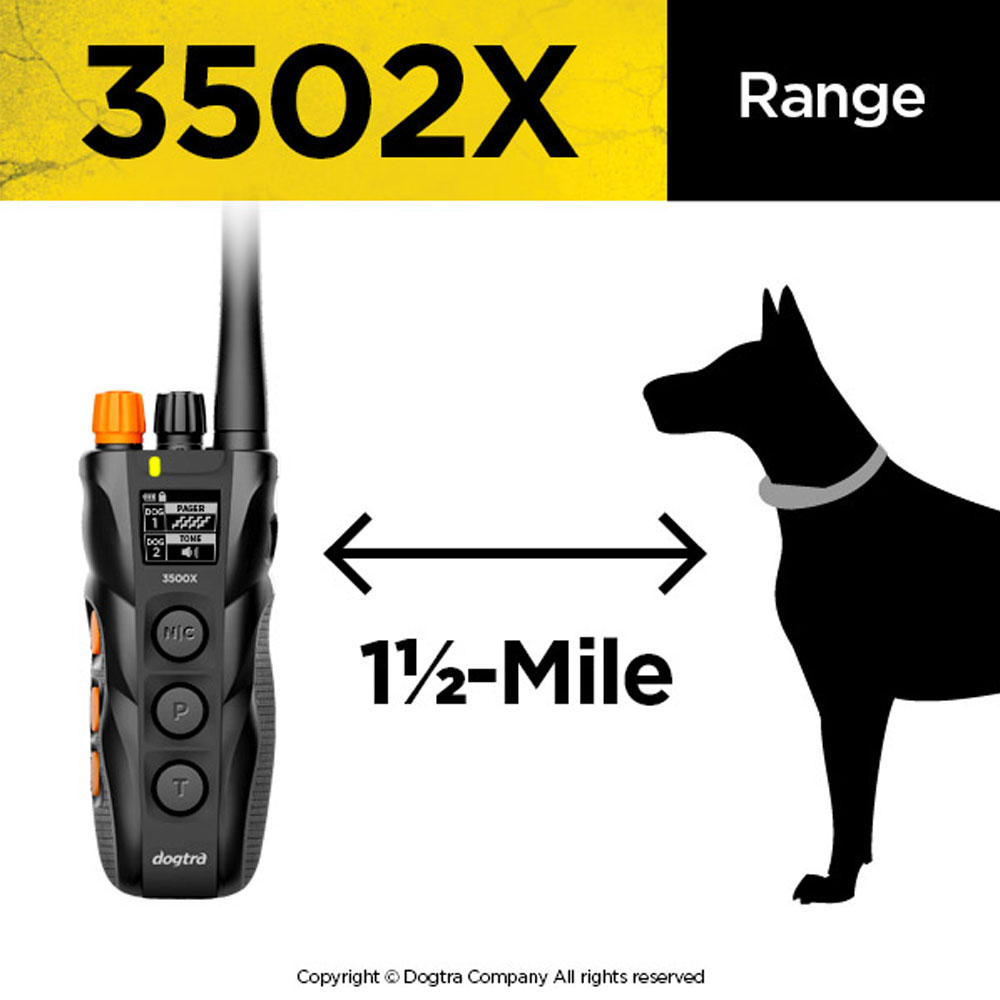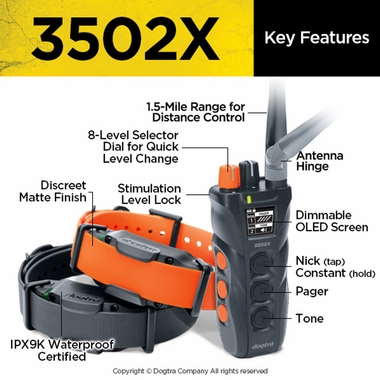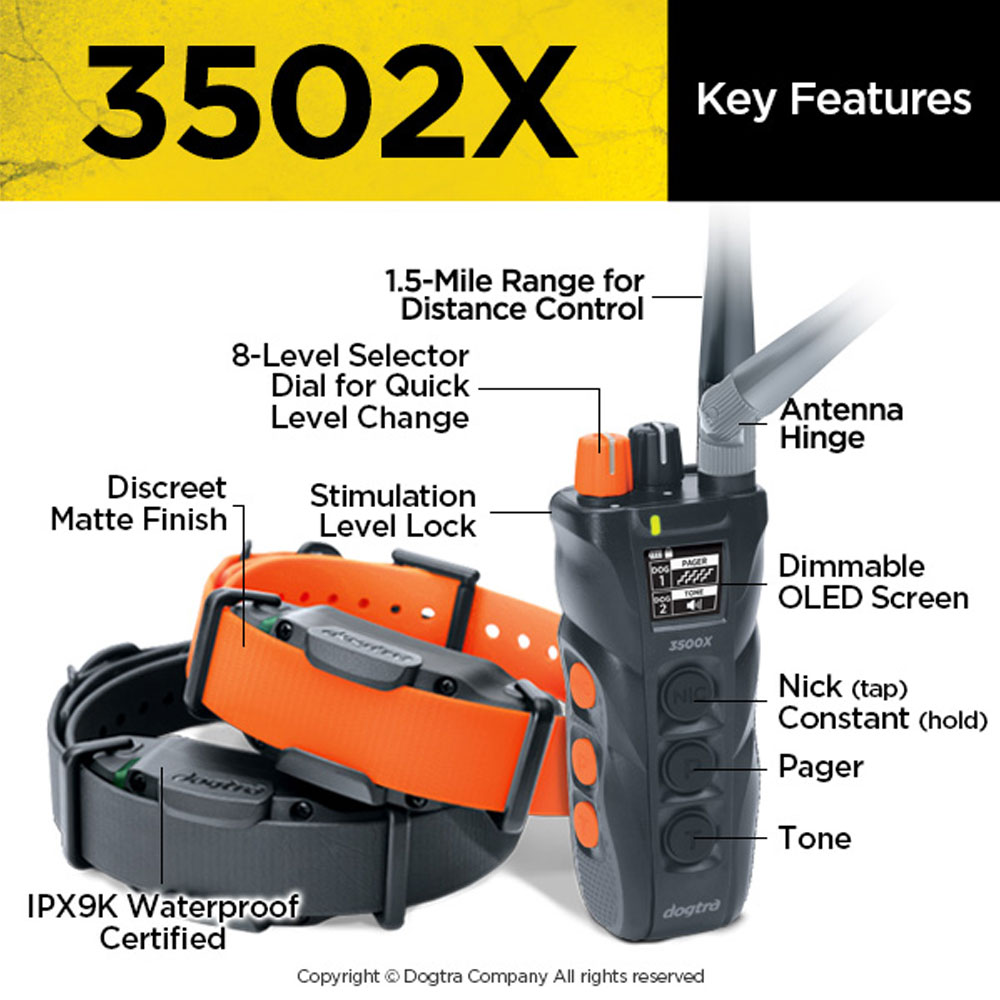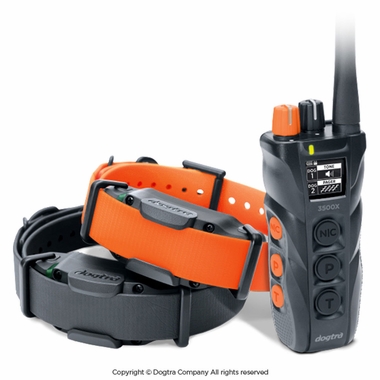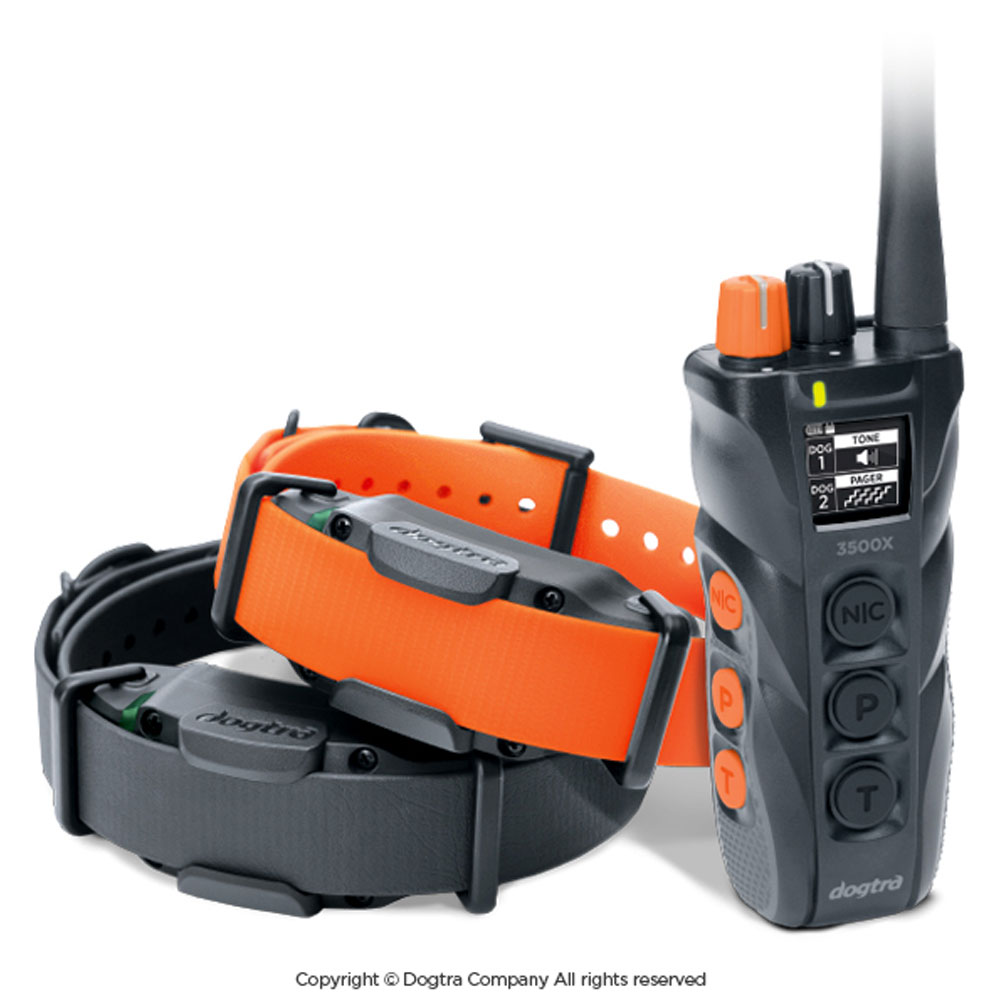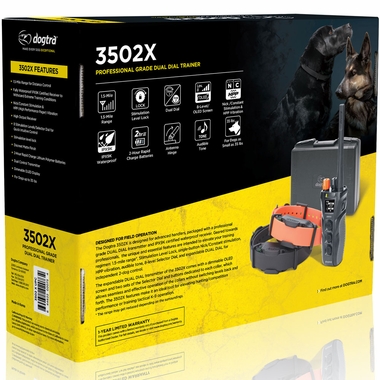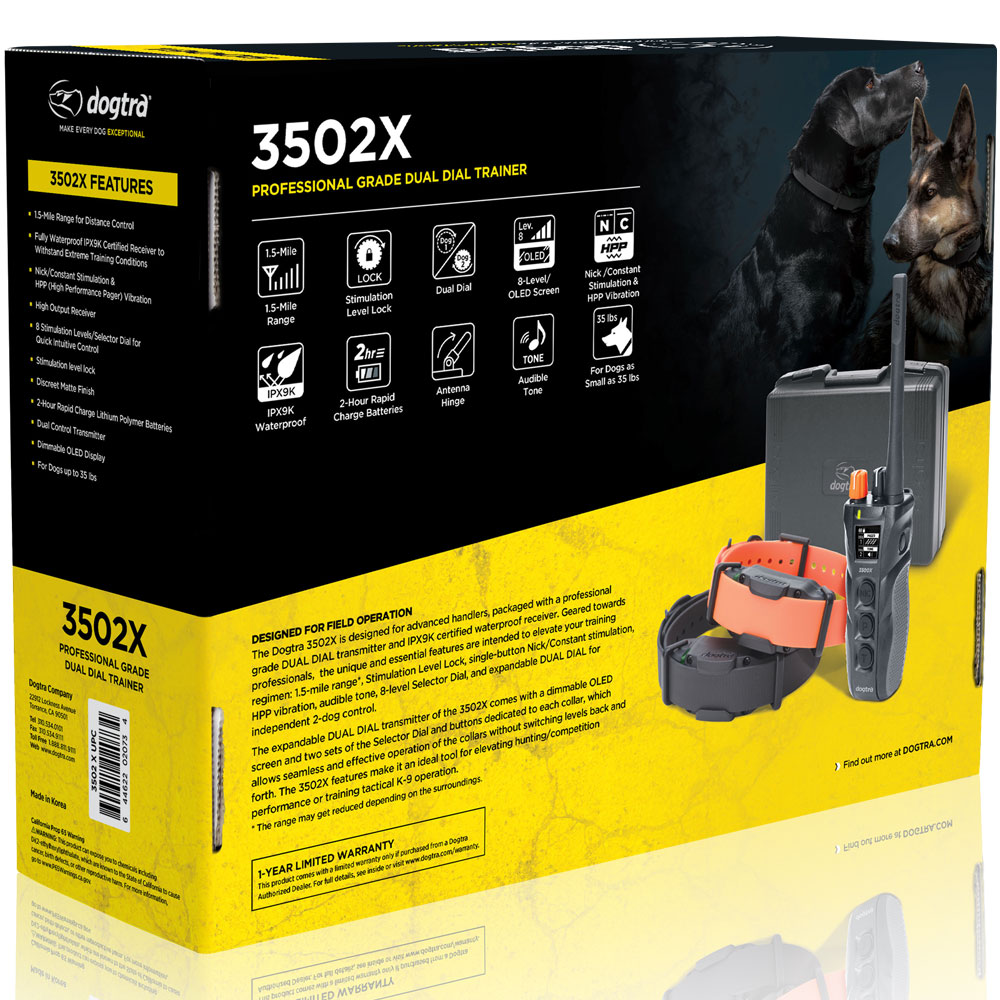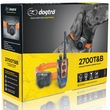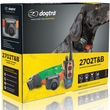Dogtra 3502X E-Collar Remote Training System 1 1/2 Mile - 2 Dog
Notice
All sales are Final. No returns or exchanges.
Description
Dogtra 3502X is designed for advanced handlers, packaged with a professional grade DUAL DIAL transmitter and IPX9K certified waterproof receiver. Geared towards professionals, the unique and essential features are intended to elevate your training regimen: 1.5-mile range*, Stimulation Level Lock, single-button Nick/Constant stimulation, HPP vibration, audible tone, 8-level Selector Dial, and expandable DUAL DIAL for independent 2-dog control.
The expandable DUAL DIAL transmitter of the 3502X comes with a dimmable OLED screen and two sets of the Selector Dial and buttons dedicated to each collar, which allows seamless and effective operation of the collars without switching levels back and forth. The 3500X features make it an ideal tool for elevating hunting/competition performance or training tactical K-9 operation.
Key Features:
- 1.5 Mile Range
- Stimulation Level Lock
- Dual Dial
- 8-Level/OLED Screen
- Antenna Hinge
- Nick/Constant Stimulation & HPP Vibration
- IPX9K Waterproof Cartified
- For Dogs as Small as 35 lbs
- Audible tone
Useful Information
View Dogtra 3502X Owner's Manual.
Turning the 3502X On/Off
To turn the handheld transmitter on, hold down the button on the right side of the transmitter until the OLED screen illuminates. To turn the transmitter off, hold down the same button on the right side of the transmitter until the OLED screen shuts off.

To turn the receiver on, hold down the on/off button until the LED indicator turns green. To turn the receiver off, hold down the on/off button until the LED indicator turns red.

Transmitter Button Function
- Safety Stimulation Level Lock Toggle Switch
- Button
- Antenna Hinge
- Remove the antenna from the transmitter by turning it counterclockwise.
- Place the Antenna Hinge in the antenna base and turn clockwise.
- Insert the antenna into the Antenna Hinge and turn clockwise.


Nick/Constant Button
There are three buttons each on the front and left side of the transmitter. The Nick/Constant button is the top button on each side of the transmitter. When the button is pressed quickly, the Nick function is activated and the receiver emits a single rapid pulse of electrical stimulation. When the button is pressed more than two seconds, the Constant function is activated and the receiver emits a continuous stimulation as long as the button is pressed, for up to 12 seconds. If the button is not released after 12 seconds, the stimulation will automatically turn off as a safety feature. The receiver will be ready to be reactivated once the button has been released.

HPP Vibration Button
The middle button is the HPP Vibration button for each side of the transmitter. Pressing it will give a vibration for as long as the button is pressed, for up to 12 seconds.

Tone Button
The Tone button is the bottom button on each side of the transmitter. Press the Tone button for a short, audible tone from the receiver for as long as the button is pressed, up to 12 seconds.


The Antenna Hinge is an accessory that extends the original range that can be lost from touching the user's body or interference from surroundings. This accessory also bends in a 180 degree direction in order to prevent antenna breakage from high physical activity or from bending over.

Receiver Fitting
Proper Fit
The receiver should be fitted so that the surgical stainlesssteel contact points press firmly against the dog's skin.You should be able to fit two fingers underneath the collar strap. The best location is on either side of the dog's windpipe.
Improper Fit
A loose fit can allow the receiver to move around on thedog's neck. When this happens, the contact points mayrub against the skin and cause irritation. If the receiveris too loose, the contact will not be consistent and causethe corrections to be inconsistent. Dogtra uses surgicalstainless steel contact points and anti-microbial plastic toprotect the dog's skin.

Attention! Leaving the receiver in the same location on the dog's neck for an extended period of time can cause skin irritation. If the dog is to wear the receiver for long periods, occasionally reposition the receiver so that the contact points are moved to a different location on the dog's neck. Make sure you check for skin irritation each time you use the unit.
Finding the Right Stimulation
The 3502X has a Selector Dial on the top of the transmitter (1 is the lowest and 8 is the highest). Remember that you will need to adjust the setting (upward or downward) depending on your dog's temperament and threshold for stimulation. Always start at the lowest level and work your way up. The appropriate level can be found when the dog responds to the stimulation with a mild reaction. Also, as the dog's attitude changes, especially during times of increased excitement or distraction, you may need to adjust the intensity level.
Note: The stimulation intensity can be adjusted even when the stimulation is in use.
Maximizing the Distance
Depending on the way you use your transmitter, the transmitter range may vary.
To get the greatest range, hold the transmitter away from your body and avoid touching the antenna. Keep your unit properly charged for maximum signal strength.

LED Indicator
The LED indicator flashes every 4 seconds when the receiver is on and ready for use. The LED indicator will blink on both the transmitter and the receiver when the transmitter buttons are pressed.
The LED indicator color indicates the battery life level.
- Green = Full charge
- Amber = Medium charge
- Red = Needs charge
If the unit is used while the LED indicator is red, it may shut down automatically.

Receiver Indicator Light
When the Constant button on the transmitter is pressed,the receiver indicator light will glow steadily (either green,amber, or red based on the remaining battery life), aslong as you hold the button down, for up to 12 seconds.When the Nick button is pressed, the light comes on for afraction of a second.
Charging the Battery

The Dogtra 3502X uses a lithium polymer battery. Recharge the unit if the indicator light is red or does not come on, the transmitter LCD shows only 1 bar on the indicator, or the system will not stay on when any button is pressed.
NOTE 1: Only use Dogtra-approved batteries, chargers, and accessories for your Dogtra e-collars. This will prevent any damage that can be incurred from attempting to use a different charger.
NOTE 2: The unit has a partial charge when it leaves the Dogtra facility. Upon receipt of the system, be sure to give it a full 2-hour initial charge before the first use away from any flammable substances.
NOTE 3: When a charger is not in use, disconnect it from the power source. Fully charge the batteries if the unit is to be stored without use for a period of 3 months or more.
Follow the steps below to charge your system:
- Open the rubber plugs on the battery charging receptacles and plug in the charging cable.
- Plug the charger into a 120-volt wall outlet or, if using the auto charger, plug into a cigarette lighter only for lithium polymer batteries (use a 220 volt European charger for Europe). All indicator lights should glow red when properly plugged in and the unit will automatically shut off during the charging process. You will need to turn the unit on again before use once the unit is fully charged and unplugged from the battery cable.
- The lithium polymer battery is fully charged within 2 hours. The lights will stay red during the charging process and turn green once the unit is fully charged.
- After charging, cover the battery charging receptacles with the rubber plugs.
Handheld Transmitter OLED

The OLED screen indicates the stimulation level on the screen ranging from (1-8). The battery life indicator shows:
- 3 bars = full charge
- 2 bars = medium charge
- 1 bar = needs charge
The battery life indicator only shows the remaining charge of your transmitter. To find the remaining charge for your receiver, observe the LED indicator light on the receiver.
The OLED screen has three settings for the brightness.
- Default = Full brightness
- Press 1st time = Partial brightness
- Press 2nd time = Screen is off
- Press 3rd time = Full brightness
Care for OLED Transmitters in Cold Temperature
In cold temperatures (10°F or below), the Organic Light-Emitting Diode (OLED) on your transmitter may be dim or slow to respond. Wait until the display becomes visible before selecting any training level. Even though the OLED screen might be dim or slow to respond when you push the Nick or Constant button, the transmitter will still function properly. In the occurrence of extremely cold weather, the OLED screen might take a moment to respond causing the intensity level to freeze at that current level. In this situation, if you turn the Selector Dial, the level on the screen may not change but the actual intensity from the receiver will change in agreement with the dial. In this situation, it is ideal to either wait until your transmitter is back to working order before emitting a correction, or while holding the Constant button down slowly turn the Selector Dial while watching your dog's reaction. Do not turn the Selector Dial rapidly, because the receiver will emit a static correction based on the level of the Selector Dial, which might not be correctly reflected on the OLED screen.
Attention! When using the unit in cold temperatures, it is recommended that the transmitter is placed under your jacket next to your body. The warmth of your body will greatly improve the battery life and usage.
Attaching the Belt Clip

Follow the instructions below to attach the included belt clip to the transmitter.
- Align the belt clip to the grooves on the back of the transmitter.
- With a firm grip, screw on the belt clip's Phillips head screws with a screwdriver.
Attention! Tighten until firmly in place. Be careful not to over tighten.
Using the Test Light

- Turn on the receiver by pressing the on/off button. The indicator light will come on for a moment then blink once every 4 seconds, showing that the receiver is ready to use (the receiver needs to be charged if the indicator light is red).
- Turn the transmitter on by holding down the on/off button on the transmitter. The LED will blink every 4 seconds and the LCD screen will show the remaining battery life.
- Place the test light, included in the package contents, on the contact points as shown in the diagram.
- Watch the test light as you push the Nick button on the transmitter. It should light up for just a moment. The higher the intensity, the brighter the test light will be. Watch the test light as you push the Constant button on the transmitter. It should light up as long as the button is pressed. However, as a safety feature, the receiver will automatically stop the stimulation if the Constant button is pressed for 12 seconds or longer.
- Watch the test light as you push the Constant button on the transmitter. It should light up as long as the button is pressed. However, as a safety feature, the receiver will automatically stop the stimulation if the Constant button is pressed for 12 seconds or longer.
- Turn the Selector Dial on the transmitter clockwise and then counterclockwise. The test light should glow brighter with higher levels of stimulation and dimmer with lower levels. When you change the intensity dial, the number on the OLED screen will change as well.
NOTE:The test light may not be visible if the intensitylevel is set below level two.
MAINTENANCE
Basic Maintenance
Be sure the rubber-charging cap is securely in place when the receiver is in use. After each training session, carefully inspect the unit for any missing parts or damage to the casing. Damaged or broken casing may affect the waterproof guarantee on the unit. After confirming that there is no damage to the casing, rinse the receiver and clean out any dirt or debris.
Storage Maintenance
The ARC should be fully charged before storing for extended periods. While in storage, the unit should be given a full charge once a month, and before the first use. Store the units in room temperature. Do not keep the units exposed to extreme climates.
Troubleshooting
If the unit is malfunctioning, please refer to the "Troubleshooting Guide" before sending it to Dogtra for service. If you have any questions or concerns, you may email them to info@dogtra.com, or call customer service at (888) 811-9111.
TROUBLESHOOTING GUIDE
- My dog is not reacting to the receiver.
- Make sure the receiver and transmitter are turned on by holding down the on/off button on the transmitter and place the two red dots together to turn on the receiver until it illuminates.
- Make sure the collar strap is tight enough so both contact points are touching the dog's skin.
- The contact points may be too short for the dog. To place an order for longer contact points that are more appropriate for your dog, please call (888) 811-9111. If you are already using the longest contact points available, you might need to trim down the hair on the dog's neck so both contact points are touching the dog's skin.
- The intensity level may be too low for your dog. Keep increasing the stimulation until the dog responds, usually with neck movement, head shaking, looking over its shoulder, etc. (response may be very subtle).
- The test light comes on, but I do not feel any stimulation.
- Your tolerance may be higher than your dogs. We recommend placing both contact points on your inner wrist, where the sensitivity is higher, in order to test the unit.
- The battery may be low, so check the LED light for battery life.
- The transmitter has no range or stimulation is less when the dog is farther away.
- The antenna(s) may be damaged. To order parts, please contact customer service at (888) 811-9111 or go to www.dogtra.com.
- The range indicated on the unit's box is for flat terrain. Heavy brush, trees, hills, or moisture will affect the range of your unit. For best range, hold the transmitter vertically above your head, and/or try moving to higher ground.
- Any electrical conductors will affect the range, such as cars, chain-link dog runs, metal structures, and radio towers. For best results, operate away from these items.
- My unit is not holding a charge.
- The batteries might not be charged properly, or the charger, splitter, and the charging port may not be functioning properly. You can send in your charging units to have us inspect them.
- The charging pin may be damaged. Inside the charging port, there is a metal pin that should be standing straight up and stiff. If the pin is wobbling, broken, or missing, you will need to send the unit in to the Repair Department. The charging port must be clean prior to charging; clean the dirt out with a cotton swab and some rubbing alcohol. If the dog is in salt-water, be sure to rinse the receiver and charging port with clean water.
- If the above does not resolve your issues, contact Dogtra customer service at info@dogtra.com or (888) 811-9111.

